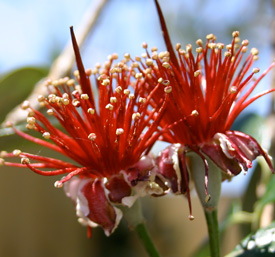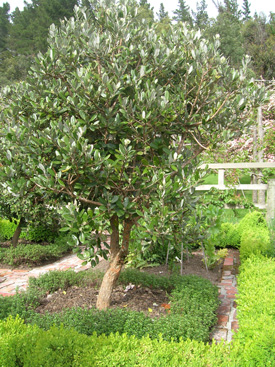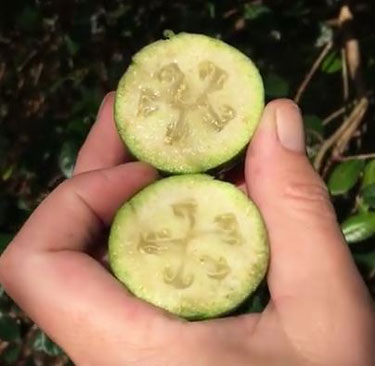Grow feijoas
So sweet, so easy
Autumn is the best time to plant feijoas
By the end of March we'll be gathering up the pretty green fruit and scooping out their exquisite aromatic flesh. The feijoa season extends through till June. By then, if we haven't had our fill of feijoa smoothies, feijoa crumble, and feijoa muffins, we can preserve what's left in chutney or jam, or bag them up for the freezer (feijoas freeze well, with or without their skin).
Since this small South American tree arrived in New Zealand in the 1920's, it's thrived and prospered in what turned out to be an ideal climate. As well, feijoa pests are scarce here, which means feijoas are grown organically, without chemical sprays.
Our warmest summer temperatures generate huge crops of large fruit, while a decent winter chill gives the best fruit set. Although feijoas are more common in North Island gardens, they're increasingly grown in the South, as early fruiting varieties are increasingly available. Feijoa fruit is damaged by frost, but the tree itself is frost hardy down to minus 8°C. Young trees may need shelter from wind as branches can snap if exposed to strong gusts.
Feijoas are a versatile shrub. They can serve as a hedge, be planted in containers, in groups within an orchard, or integrated into ornamental garden plantings. The trees typically reach a height of 2m to 3m and a width of approximately 1.5m to 2m.
Plant feijoas from mid-autumn to early spring – the earlier the better, as in autumn there is still some warmth in the soil to drive plant growth before winter.
Plant at least two different varieties to aid pollination, increase fruit yield and lengthen the harvesting season. Some varieties are self-fertile, but even these will produce heavier and more regular crops if they are pollinated by other varieties.
FUN FACT
Feijoa flowers are mainly pollinated by birds, with some help from wind and bees. Keeping the shrub open will attract birds, resulting in more fruit.
Choosing a variety
This is a selection of recommended varieties, listed in order of fruit maturity from early to late season.
- March to April harvest
- Kakariki: Exceptionally sweet, large fruit.
- Kaiteri: A prolific cropper with large smooth fruit on a vigorous tree.
- Unique: The only truly self-fertile variety so useful if you have room for only one tree. Medium size fruit, smooth, soft & juicy flesh.
- April harvest
- Pounamu: Medium size fruit with a dark skin. Smooth, aromatic, rich flavoured flesh. Good storage.
- Apollo: Large long fruit. Sweet with good eating quality.
- Kakapo: Medium size fruit with mild sweet flavour.
- May to June harvest
- Wiki Tu: Very large fruit, good taste and smooth texture.
- Opal Star: Medium to large fruit. Smooth flesh, juicy and very aromatic.
- Golden Goose: Large to extra-large fruit, ripen to very sweet once picked.
TIP
If you need a small tree, Wiki Tu has a dwarf habit with big fruit, however any variety can be pruned hard to keep the size constrained.
How to grow feijoas
- Choose a variety that is right for your climate. Planting two or more varieties is recommended as most feijoas are not self-fertile, and even self-fertile varieties fruit more prolifically when grown near a pollinator.
- Plant in a warm sunny location with well-drained soil.
- Feed with balanced NPK fertiliser in spring and summer.
- Water young trees during dry summer weather. Well-established trees have excellent drought tolerance.
- Protect from wind and frost, especially while trees are young. When grown in pots, trees may be moved to warmer spot for the cold season.
- Prune in spring.
Pruning, while not essential, helps maintain a tidy manageable size and lets light and pollinators into the tree while stimulating the tree to produce more fruiting wood. However, it is important to prune at the right time. Fruit forms at the base of new growth, so prune early in spring (after the risk of frosts) to allow time for growth and flowering. Without any pruning, your feijoa tree may reach 4 or 5m tall and wide. - Pick often. 'Touch picking' daily is best to avoid fruit falling to the ground where it quickly begins to rot. Fruit is ripe when it comes away from the stalk cleanly and easily, when gently pulled. Fallen fruit should be eaten or preserved without delay.
- A feijoa hedge
Feijoas make attractive hedges for shelter and screening. For a hedge with loads of fruit, plant named varieties. Seedling trees are generally low yielding by comparison. Trim hedges early in spring if you want fruit. - Feijoas in pots
Provided it is watered and fed regularly a feijoa tree will grow and fruit in a large container for many years. You may need a pair for best pollination. Plant in best quality container mix and feed during spring and summer with slow release fertiliser.
In the kitchen
Feijoas are rich in vitamin C and delicious either raw or cooked ...
- Process feijoa flesh in a blender, by itself or with other fruit for a nutritious smoothy. No added sugar needed.
- Make feijoa crumble. You can substitute feijoas for apples in any dessert, cake or muffin recipe.
- Dice fresh feijoas and add a little lemon juice to make a simple salsa to serve with meat.
- Make feijoa chutney.
- Stew feijoas and keep them in the fridge to eat with breakfast cereal, or as a desert with custard or ice cream.
- Gently poach whole peeled feijoas in red wine syrup and serve with vanilla ice cream, or blue cheese.
Feijoa and ginger muffins
1 cup self-raising flour
1 cup fine rolled oats
1/2 cup brown sugar
1/2 tsp baking soda
2-3 tsp ground ginger
75g butter, melted
3/4 cup milk
1 egg beaten
1 cup feijoa flesh
Preheat oven to 200°C.
Mix together the first 5 (dry) ingredients.
Mix together the last 4 (wet) ingredients in a separate bowl.
Gently combine the wet and dry ingredients until just mixed.
Spoon into greased or non-stick muffin pans and bake for 12-15 mins.
22-Feb-2013

Feijoa flower
With its Pohutukawa-like flowers and incredible
productivity, the easy care feijoa tree is so at home in
New Zealand it almost seems like a native.

Feijoa Kaiteri

Feijoa tree

Feijoa fruit


